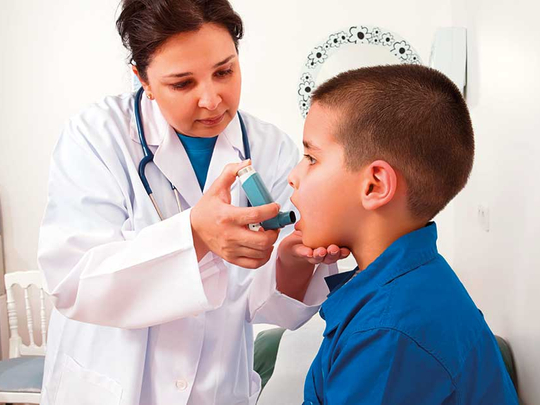
Dubai: With around 13-14 per cent of school-aged children suffering from asthma in the UAE, parents are urged to take their children for regular check-ups and understand the triggers and allergens of the condition.
While not all children have the same symptoms, parents may notice some of asthma’s most common indicators including chronic coughing, heavy breathing, chest tightness, wheezing, shortness of breath, and avoidance of physical activity.
Dr Badi Alatasi, consultant paediatrician at Valiant Clinic, told Gulf News that despite many children having a mild condition of asthma, a few of them might experience life-threatening events, especially if left undiagnosed and untreated.
“The ‘Pulmonary Function Test’ may help in the diagnosis. The test can be reliable if a child can take a deep breath and exhale deep enough on commands. The diagnosis is mostly made clinically and the response to treatment can be a way of making the diagnosis,” he explained.
Dr Alatasi also referred to exercise-induced asthma, pointing out that young patients who experience symptoms only while exercising can also be examined through a test called the ‘Exercise Bronchial Challenge’ where the child will be asked to run on a treadmill.
“Exercise-induced bronchospasm is common in school-age children. It is expected that one in 10 children will experience respiratory symptoms due to bronchospasm with intensive physical exercise,” said Dr Alatasi.
He explained that children with asthma are very likely to experience worsening of symptoms during intense exercise, which will then affect their ability to perform sport, if they do not seek adequate treatment.
He also pointed out that many Olympic athletes, including many gold medallists, have exercise-induced asthma — but because of adequate medical attention and therapy, their asthma does not limit their results.
A sufficient warm-up can also help reduce the risk of bronchospasm, along with sports that require less hyperventilation, said Dr Alatasi.
“Swimming, theoretically, is a good sport because of humidification of the air. But in reality it can be as challenging for our children’s airways as any other intense sport activity because of the sanitisation of the water in the pool,” he said.
Allergens and triggers
Parents should also try to keep an eye out for symptoms that may be triggered after specific exposure to allergens. Dr Alatasi referred to house dust mites as the most common allergen children in the UAE are sensitive to.
“We find them everywhere, especially in our bed linens. We also cant forget that our pets and best friends — cats, dogs or horses — can also give respiratory symptoms,” he said.
Meanwhile, Dr Fabrizio Facchini, consultant pulmonologist at Valiant Clinic, referred to the weather as a factor that significantly influences our exposure to triggers. “The lack of rain increases the number of particles in the air, should they come from natural events (sand storms) or from traffic or industrial pollution,” he said.
Dr Facchini pointed out that the summer time might be significantly challenging because of indoor air-conditioning, making many people exposed to brisk change of temperature and dry air.
He highlighted that poor maintenance of the AC can also expose children to bad quality of air inside the house.
Other common triggers of asthma symptoms, which emerge during the winter months, are viral infections.
Other triggers can also include exposure to irritants such as cigarette smoke, perfumes and incense, and intense exercise, which leads to hyperventilation.
“Some patients can also have symptoms when they’re simply laughing with friends, if asthma is not well controlled. Occasionally, food can cause respiratory symptoms. In many of the cases, this is due to a cross reactivity with a respiratory allergen,” said Dr Facchini.
Latest treatment
After taking the Pulmonary Function Test and asthma is diagnosed, parents can familiarise themselves with their child’s medication and devices to further ease the process. “Knowing how to measure the peak flow properly, how to use dry powder inhalers or metered dose inhalers (spray) with a spacer device can make a difference between a life without symptoms of asthma or a life troubled by asthma,” said Dr Facchini.
He pointed out that while many parents worry about contents of asthma medications, the amount of steroids included in the inhalers prescribed to children is usually very low, between 100 and 1000 less of what is contained in a steroid tablet. “It is unlikely that inhaled asthma therapy will affect a child’s growth, however it is more likely to impact them if asthma is left untreated. Uncontrolled asthma may mean an increased number of days lost from school and increased level of care required by parents,” he explained.
The doctor may prescribe a device called Peak Flow Meter, if the child is above four-six years and can use it. “The results of using this device will help you decide when to use the bronchodilators (e.g. Ventolin), when to visit the doctor and when you need to rush to the emergency room,” added Dr Facchini.












